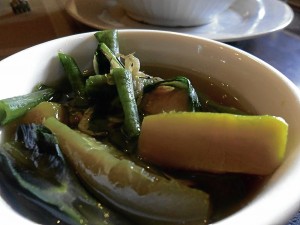We hit the ground running, so to speak. After emerging from the Iloilo airport, it was a quick lunch at Esca restaurant before judging a cooking competition, the second “Tabu-an: Western Visayas Ilonggo Heritage Cooking.”
Chef Miguel Cordova, who was also judging that day, made sure we enjoyed many of his dishes—a great welcome indeed to this cuisine-rich Visayan city. Laswa was predictably sweet because the vegetables were fresh, simply boiled and seasoned minimally. Bagongon (black cone shellfish) cooked in yams and coconut milk was heavy but so flavorful. Native chicken was cooked as adobo sa dilaw (turmeric). Shrimps were boiled then fried a bit, the shell clinging to the flesh, a sure sign that those were fat because it was molting season.
Kawilhayan festival
The setting this time for the second Tabu-an was in the municipality of Sta. Barbara, which was celebrating the 114th year of its revolution against Spain with a festival called Kawilhayan. But even without a festival, Sta. Barbara has attractions that can make a visit worthwhile, such as the town church and the oldest golf course in the country.
This town was once called catmon, after the tree that produces beautiful white flowers and green apple-like fruits that are used to sour sinigang dishes. Yet when I asked Chef Tibong Jardeleza, untiring organizer of Tabu-an, about the tree, the query drew a blank stare, possibly because today, there is only one catmon tree existing in Sta. Barbara. It was in Infanta where I encountered the tree for the first time, and thought its fruit was beautifully designed with its swirling green structure inside that contrasted with the magenta threads shooting out of the stem.
Ilonggos are more familiar with alumpiran, the leaves of which are used for souring. One of the competitors, the K Carsi Culinary School, used those to flavor the young native chicken (damuraga nga darag) in the dish pinaisan nga darag sa kuron. They mixed together all the ingredients, which also included garlic, ginger, shallot, langkawas (blue ginger), lemongrass, salt and coconut cream, then slow-cooked these in a clay pot (kuron) for an hour.
The group also made adobado nga biga-biga, braised pig’s innards cut into bite-size pieces—perfect for feasts, and made orange with achuete oil. The group won second prize; the members chose the dishes well, because after all the chopping, slicing and mixing, they just had to wait until the food was cooked over charcoal.
The contestants were busy since morning completing their three-course menu. We were in time to grade the preparation and correct procedure of the six groups.
Good laugh
Aklan State University did ukoy nga talaba (oysters in batter) and squid relleno, both of which required too much chopping, which worked against the team. West Visayas State University made kilawin nga baboy (fried pork seasoned with a vinegar mix) and pochero nga guya ng baka (beef face or maskara) with some pork knuckles cooked with tomato sauce in the Spanish style.
Finally, I saw how the panara was made, the turnover, or empanada, with an outer shell made with rice flour. Each was filled with shrimp and mongo sprouts, shaped into a half-moon then placed on banana leaves from which each piece slides down to the hot oil.
The IRC Sta. Barbara, which made the panara, also made pancit efuven (egg noodle) with steamed shrimps (tinuom nga pasayan), uhong (mushroom) and patola (sponge gourd). We had a good laugh, though, about the brand name of the pancit efuven, which read “Streams in the Desert.”
Third place went to Colegio del Sagrado Corazon de Jesus, which did fresh lumpia made with ubod (coconut pith) and lengua con setas con olivas (ox tongue with mushrooms and olives).
Tasty offerings
It was quite delightful to know that the first place went to a group that belong to the Barangay Nutrition Scholars of Santa Barbara, the host town. They made two dishes that seemed unattractive at first. There was nilagpang na pantat (hito, catfish), fish grilled then picked (the bones discarded), mixed with grilled onions and tomatoes, flavored with vinegar, sugar, soy sauce and chili, then added with hot water to make a curious but tasty soup.

For the main course, it was escabeche of lison, sweet and sour dried fish. Both were so tasty, and I’m sure the guests that evening who sampled all the food must have noticed as well. Like last year, the awarding ceremony involved a dinner where the competitors cooked for several guests, giving them a taste of what the judges had a few hours before.
The contest and the rest of the visit was a feast for us, the judges. It was also a time to connect with many of the figures in the culinary industry.
Our thanks to Cebu Pacific for bringing us there. And to Amigo Terrace Hotel, which pleasantly surprised me with its remodeled rooms, refurbished with first-class amenities, from when I was last there. This January should be a great time to go to celebrate Iloilo’s Dinagyang, the feast of the Sto. Niño.
E-mail pinoyfood04@yahoo.com